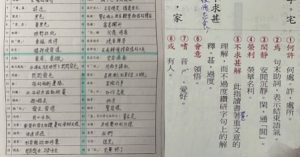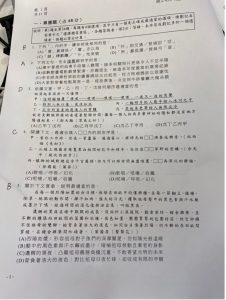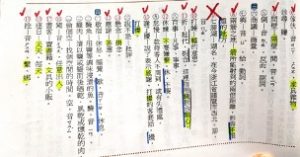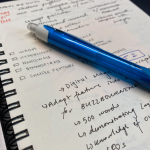 Produced by Iris Tseng
Produced by Iris Tseng
Rigid Rulers vs Radiant Rebels: The comparison between authority teaching method and flexible as well as encouraging teaching style.
The biggest difference in teaching methods between Taiwan and the UK is the fact that back home everything has a correct answer, and the teaching is more one-way and authority-based; whereas, in the UK, the teaching methodology is more flexible and creative. In this blog, I will talk about what are the differences that I observed when I was a student here.
Classroom Interaction
 The interaction in class is probably one of the biggest differences that I have observed. You may wonder why, but frankly, the students in and from Asia tend to be shy and timid. They construe teachers, lecturers and professors as the authority, they can’t question their lecturers or propose an unusual, creative way to interpret/ resolve the question. Everything has a correct answer; everything lecturers say is the only answer. All of these factors result in one scenario, which is when you go into a classroom or a lecture in Taiwan, you will find that the only people who are constantly talking in the class are the lecturers, there are rarely any questions or doubts from the students towards the content they are delivering. The students are so quiet as if they are statues or study machines who passively absorb the knowledge from their lecturers. There’s barely any interaction.
The interaction in class is probably one of the biggest differences that I have observed. You may wonder why, but frankly, the students in and from Asia tend to be shy and timid. They construe teachers, lecturers and professors as the authority, they can’t question their lecturers or propose an unusual, creative way to interpret/ resolve the question. Everything has a correct answer; everything lecturers say is the only answer. All of these factors result in one scenario, which is when you go into a classroom or a lecture in Taiwan, you will find that the only people who are constantly talking in the class are the lecturers, there are rarely any questions or doubts from the students towards the content they are delivering. The students are so quiet as if they are statues or study machines who passively absorb the knowledge from their lecturers. There’s barely any interaction.
 Whereas, in the UK classroom, from what I have observed, the classrooms are always full of discussions and noises. Students and lecturers will constantly discuss the topic with each other, students are able to question the theory that the lecturers showed them. Lecturers seem to be friends with the students. Most of the time, I have seminars that consist of 10-15 people and my lecturers would come to each table to discuss and debate the topic we were viewing today. We are allowed to raise doubts towards the ideas that the lecturers demonstrated, the lecturers are also so delighted to see some students trying to challenge and resolve the question differently. Students and lecturers will cooperate and discuss, if the solution that the lecturers illustrated has some questions, what can we do to resolve it? We all become researchers at that moment- both lecturers and us. There’s no such thing as authority and you must obey whatever your lecturers say. Of course, a basic manner; such as learning etiquette and attendance should always be aware of, but unlike the classroom in Taiwan, I’m allowed to raise my questions whenever I want, further, triggering and kindling my passion for this particular topic/ subject. Therefore, you will never find a British lecture quiet (unless it is exam season); otherwise, it is always and always full of noise and discussion.
Whereas, in the UK classroom, from what I have observed, the classrooms are always full of discussions and noises. Students and lecturers will constantly discuss the topic with each other, students are able to question the theory that the lecturers showed them. Lecturers seem to be friends with the students. Most of the time, I have seminars that consist of 10-15 people and my lecturers would come to each table to discuss and debate the topic we were viewing today. We are allowed to raise doubts towards the ideas that the lecturers demonstrated, the lecturers are also so delighted to see some students trying to challenge and resolve the question differently. Students and lecturers will cooperate and discuss, if the solution that the lecturers illustrated has some questions, what can we do to resolve it? We all become researchers at that moment- both lecturers and us. There’s no such thing as authority and you must obey whatever your lecturers say. Of course, a basic manner; such as learning etiquette and attendance should always be aware of, but unlike the classroom in Taiwan, I’m allowed to raise my questions whenever I want, further, triggering and kindling my passion for this particular topic/ subject. Therefore, you will never find a British lecture quiet (unless it is exam season); otherwise, it is always and always full of noise and discussion.
Pedagogy (Teaching approach)
 The other thing I found quite interesting to compare is the difference in pedagogy between Taiwan and the UK. How could it be so different? You might ask. As I mentioned above, Taiwanese pedagogy is prone to be authority-based; Nevertheless, British pedagogy is more flexible. From my experience, when I was studying back home, the only two learning approaches I encountered were read/write, auditory and visual. We sat in the classroom, started listening and writing and began to memorise everything. It was a very boring and sometimes could be an efficient method as you got to practice again and again, your brain will instantly recognise this particular question and know how to answer it. You wouldn’t think for a second and wonder why this and how that, everything is just like computer code that inserts into your head. This method is brilliant when it comes to a situation that you only have a short period of time, but you need to absorb as much knowledge as you can. However, in the long term, you will not be able to memorise or remember any of the knowledge: you never actually comprehend it.
The other thing I found quite interesting to compare is the difference in pedagogy between Taiwan and the UK. How could it be so different? You might ask. As I mentioned above, Taiwanese pedagogy is prone to be authority-based; Nevertheless, British pedagogy is more flexible. From my experience, when I was studying back home, the only two learning approaches I encountered were read/write, auditory and visual. We sat in the classroom, started listening and writing and began to memorise everything. It was a very boring and sometimes could be an efficient method as you got to practice again and again, your brain will instantly recognise this particular question and know how to answer it. You wouldn’t think for a second and wonder why this and how that, everything is just like computer code that inserts into your head. This method is brilliant when it comes to a situation that you only have a short period of time, but you need to absorb as much knowledge as you can. However, in the long term, you will not be able to memorise or remember any of the knowledge: you never actually comprehend it.
 However, from my four years’ experience studying in the UK, my teachers and lecturers not only utilised visual, auditory and read/write, but they also included kinesthetic as well as verbal learning approaches. I had lots of units that required me to conduct practical experiments, projects and productions. I am able to fully comprehend the theories and concepts behind those topics when the lecturers used kinesthetic and verbal teaching approaches because before I delivered the presentation or worked on the projects, I had conducted a huge amount of research explaining why I should use this concept, why this methodology, how to convey the idea, etc. The research allowed me to understand the questions thoroughly, which leads to long-term memory. However, the downside of this teaching approach is that it takes lots of time to learn and prepare, and it is less efficient than my experience in Taiwan.
However, from my four years’ experience studying in the UK, my teachers and lecturers not only utilised visual, auditory and read/write, but they also included kinesthetic as well as verbal learning approaches. I had lots of units that required me to conduct practical experiments, projects and productions. I am able to fully comprehend the theories and concepts behind those topics when the lecturers used kinesthetic and verbal teaching approaches because before I delivered the presentation or worked on the projects, I had conducted a huge amount of research explaining why I should use this concept, why this methodology, how to convey the idea, etc. The research allowed me to understand the questions thoroughly, which leads to long-term memory. However, the downside of this teaching approach is that it takes lots of time to learn and prepare, and it is less efficient than my experience in Taiwan.

But overall, I think both educational systems have their own pros and cons, it really depends on which situation you are in, I do find the Taiwanese teaching approach helps me a lot when I’m in an emergency scenario; but in the long run, the British teaching approach might be a better solution for me.
Marking Scheme & Assignment
 The marking scheme as well as assignments are the other things that I think it is quite different from my home country’s. Let’s dive into the Taiwanese marking scheme and assignment first. The marking scheme in Taiwan is fairly simple. Because of the learning approach, most of the time, the question has one and only correct answer, if you get it wrong, you lose the mark. How to prepare for your exam? You have to read as many textbooks as possible to memorise the answers. There are no flexible answers. As for the assignment, it is also the same! The assignment is normally multiple choices, you need to analyse which one is wrong and which is right, then select the correct answer. We rarely have analysis, written essays or reflective essays.
The marking scheme as well as assignments are the other things that I think it is quite different from my home country’s. Let’s dive into the Taiwanese marking scheme and assignment first. The marking scheme in Taiwan is fairly simple. Because of the learning approach, most of the time, the question has one and only correct answer, if you get it wrong, you lose the mark. How to prepare for your exam? You have to read as many textbooks as possible to memorise the answers. There are no flexible answers. As for the assignment, it is also the same! The assignment is normally multiple choices, you need to analyse which one is wrong and which is right, then select the correct answer. We rarely have analysis, written essays or reflective essays.
 However, the UK marking scheme and assignment seem to be various. There are multiple choices, presentations, discussion/analysis, and written or video essays. They provide us with a clear assignment brief and criteria for each level. Students who want to score high must follow the marking criteria and conduct lots of research, references and analysis to demonstrate that they fully comprehend this topic and this is what I found. Sometimes, the marking can be quite objective and this is where it starts getting controversial. However, if you put lots of effort into your assignment but don’t follow the marking scheme, there’s no guarantee that you will get a 70; instead, you might fail. If you put a relatively enough amount of effort into your assignment, but followed the criteria, you might at least score a 50. As a result, the grading and assignments are comparatively more challenging than the Taiwanese grading. It is more objective and flexible, containing a number of personal opinions and analyses, whereas, Taiwanese ones only have one official correct answer that can’t contain your personal perspective.
However, the UK marking scheme and assignment seem to be various. There are multiple choices, presentations, discussion/analysis, and written or video essays. They provide us with a clear assignment brief and criteria for each level. Students who want to score high must follow the marking criteria and conduct lots of research, references and analysis to demonstrate that they fully comprehend this topic and this is what I found. Sometimes, the marking can be quite objective and this is where it starts getting controversial. However, if you put lots of effort into your assignment but don’t follow the marking scheme, there’s no guarantee that you will get a 70; instead, you might fail. If you put a relatively enough amount of effort into your assignment, but followed the criteria, you might at least score a 50. As a result, the grading and assignments are comparatively more challenging than the Taiwanese grading. It is more objective and flexible, containing a number of personal opinions and analyses, whereas, Taiwanese ones only have one official correct answer that can’t contain your personal perspective.


 Three things to focus for the month of deadlines
Three things to focus for the month of deadlines 5 Healthy & Simple Recipes
5 Healthy & Simple Recipes How I met my first classmate at BU
How I met my first classmate at BU








